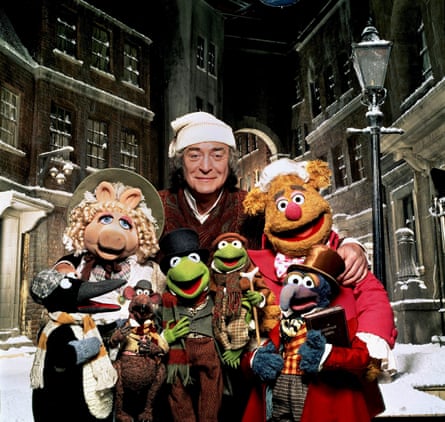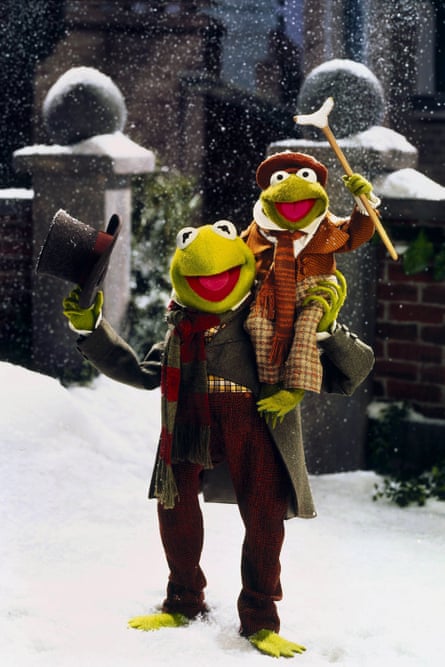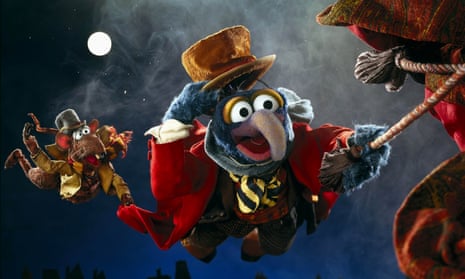Brian Henson, director
My father, Jim, passed away in 1990. He had done three Muppet movies, and I didn’t want too much of a direct comparison between me and my dad. So I thought: “Let’s do something different.” Our agent, Bill Haber, said to me: “Christmas Carol is the greatest story of all time, you should do that.” While I was thinking about it, he called me back and said: “I’ve sold it to the ABC TV channel.”
We set to work on the script. The Muppets are famous for questioning the status quo, and anti-establishment irreverence, so we took that and pointed it at Charles Dickens. Robin the Frog was going to be the ghost of Christmas past, Miss Piggy was going to be this bacchanalian ghost of Christmas present, and Animal was going to be the ghost of Christmas yet to come. We were going to do a romping parody.
Then we stopped and reconsidered. Nobody had ever captured Dickens’s prose – the wonderful way he described the scenes. So we had to put Charles Dickens in the movie. Who’s the least likely character to be Charles Dickens? Gonzo! So we made him this omniscient storyteller, with Rizzo his pain-in-the-neck sidekick. Ninety-five percent of what Gonzo says in the movie is directly taken from the book.
When I met Michael Caine to talk about playing Scrooge, one of the first things he said was: “I’m going to play this movie like I’m working with the Royal Shakespeare Company. I will never wink, I will never do anything Muppety. I am going to play Scrooge as if it is an utterly dramatic role and there are no puppets around me.” I said: “Yes, bang on!” He was intimidating to start with, but he’s a delight.
Filming it was completely terrifying. I was 28 – I did not feel ready to do a movie. I begged other people to direct. Jeffrey Katzenberg could see that it was an emotionally fragile environment, and he kept his production department away from me. When Scrooge comes home and he’s an angry, lonely man, and the first ghosts show up, I knew I was going to scare people. There were kids crying in the cinemas [when the film was released in 1992]. But then when Jacob Marley and his brother Bob come out, they’re singing the catchiest tune in the movie. You need to go to those dark places for the ending to be as joyous as it can be.

Steve Whitmire, performer, Kermit and Rizzo
I was taking over from Jim as Kermit, which was a little scary, as you might imagine. It was important not only to match Kermit’s character, but also his voice. Jim and I don’t sound exactly alike, and the night before we pre-recorded the songs, I had a lot of trouble getting to sleep, thinking: “I really want this to be good, this means so much to everybody.”
Then I had a bizarre dream. I was in this building that was all white, and Jim was there. He comes over to me, in a hurry to get somewhere quickly. I said to him: “I’m really nervous about taking over Kermit.” He looked at me. Jim would do this thing where he would take one finger and put it on his bottom lip as he was thinking – he thought like this for a second and said: “It’ll pass.” And he walked away. It felt much more like a visit than a dream. The feeling from that gave me confidence for the whole film.
Bob Cratchit was a natural role for Kermit, the caring person who looked after people. He was almost playing himself. I also performed Rizzo the Rat, a character I had originated and had been doing for a dozen years by that point, which was all goofing around – it was a great release. When the director said “Cut”, the characters stay alive for a while at the end of the scene, and they continue to talk: “How was that? Did we do a good job?” Plus some comments I can’t put out for public consumption. Various scenes came out of that improvisation.
Kermit is an extremely simple puppet – he’s just a piece of fabric draped over the performer’s hand. I’ve really worked to expand the amount of expression you can create with him. On our new show, we’ve had Kermit talk out of the side of his mouth, and Kermit’s smile is something that Jim really didn’t do.
On my best days, I have this sense that I’m channelling Jim in some way. We and Kermit all share a dualistic view on life, where the good stuff and the bad stuff equals itself out. Kermit looks for equanimity in things: he sees the best in people, and sees the worst in people, and nurtures them beyond that without criticising them. It’s the way Jim was, and it’s the way I’ve tried to operate in my own life as well.
Dave Goelz, performer, Gonzo and Waldorf
Jim kept a gruelling schedule, but every meeting with him, even if it was with his accountants, was full of laughter. The idea of him being stricken was the furthest thing from our minds. He died very suddenly, and we were just flattened by it. Brian called a meeting to see whether we wanted to continue without Jim. And every single one of us said: “It just feels like our life’s work, and we’d like to try and go ahead.” That was about 5pm on the day he died.

By the time the work on Christmas Carol started, the really intense grieving was done. It was such a soulful piece, and a chance to carry on the heart of Jim’s work: the idea that people were basically good, and there was enough in the world for everyone. It was cathartic. Brian was incredibly good, right from the beginning. Michael Caine got halfway through the film before he found out it was Brian’s first time directing – he couldn’t believe it.
The Muppets are a big psychodrama where you feed your personality and fears through your characters. I usually search for a flaw of mine I can use for comedy, and then I try to find a way to make it lovable – for example, the clumsy Travelling Matt character in Fraggle Rock came out of wanting to preserve my dignity and not be shamed in front of people.
It was the same with Gonzo. When he appeared in the 1970s, he was really pathetic, he didn’t have much confidence. And that came from me. I had suddenly found myself in showbusiness and I thought: “How did I get here from the sofa? I have no idea how to do this.” So I asked Jim Henson if I could build a new Gonzo with an eye mechanism that could allow him to look excited – this was his second phase, with this zany, bombastic appreciation for life.
Then, in the early 80s, I started therapy and it really transformed me, and Gonzo, too. I had always seen myself as not having children, and then people would bring their kids to the set of Fraggle Rock, and I found myself tearing up. I ended up getting married and having two wonderful kids. I was unlocking my emotions. When the screenwriter of Christmas Carol, Jerry Juhl, cast Gonzo as the wise Charles Dickens, that ushered in Gonzo’s soulful phase.
Playing the heckler Waldorf though, one of Jim’s characters – I was reluctant. Of course, I wanted to be supportive, but really I wanted Jim to come back instead. For the following 15 or 16 years I did Waldorf, I just thought: “I’m a placeholder.” I didn’t ad lib, I just did the dialogue. And then one day it occurred to me I had done Waldorf longer than Jim had, and that Jim was not coming back. So I might as well try to own it.
I’ve never been able to watch Christmas Carol dry-eyed. The comedy deepens the emotion – it ambushes you. It remains my favourite film we’ve done by a good margin. It’s such a powerful piece of literature, and to be able to do it with our goofy characters and make it work, it’s a huge satisfying success.

Comments (…)
Sign in or create your Guardian account to join the discussion